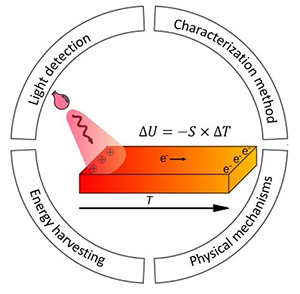
Recently, a research group led by Prof. JIANG Peng and Prof. BAO Xinhe from the Dalian Institute of Chemical Physics (DICP) of the Chinese Academy of Sciences (CAS) reviewed the progress of photodetectors based on the photothermoelectric effect. And this article was published in Advanced Materials.

Schematic of PTE conversion process, and the summary of the application fields of PTE effect. (Image by LU Xiaowei)
Photodetectors operating in the long wavelength infrared (LWIR, 8 - 14 μm) and terahertz (30 μm - 3 mm) ranges have important applications. Photothermoelectric detectors, which combine the photothermal and thermoelectric processes, can be utilized to realize the room-temperature detection of LWIR and terahertz radiations in the self-powered mode. The high-performance photothermoelectric detectors are playing a more important role in the LWIR and terahertz detection.
This review summarized the recent advances in the photothermoelectric detectors based on the low dimensional materials, bulk porous materials and organic materials. The strategies, such as surface plasmon, phonon absorption, and optical antenna, to enhance the interaction between light and matter and then improve the performance of photothermoelectric detectors were highlighted.
Furthermore, the applications of photothermoelectric effect in the investigation of novel physical phenomena in the near-field optics, spintronics and valleytronics were introduced. And the promising research direction of photothermoelectric detectors was envisioned.
This work was supported by the National Key Research and Development Program of China and Dalian Institute of Chemical Physics. It was dedicated to the 70th anniversary of DICP, CAS.

86-10-68597521 (day)
86-10-68597289 (night)

86-10-68511095 (day)
86-10-68512458 (night)

cas_en@cas.cn

52 Sanlihe Rd., Xicheng District,
Beijing, China (100864)

